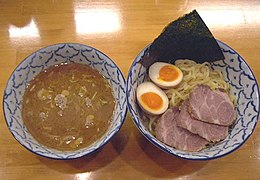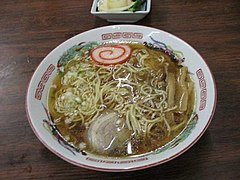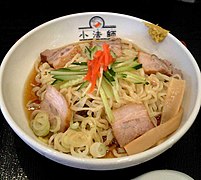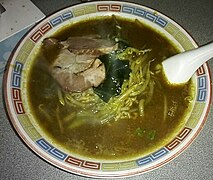Ramen
 | |
| Alternative names | Nankin soba, shina soba, chūka soba |
|---|---|
| Type | Noodle soup |
| Place of origin | Japan China (origin) Yokohama Chinatown, Japan (adaptation) |
| Region or state | East Asia |
| Main ingredients | Chinese-style alkaline wheat noodles, meat- or fish-based broth, vegetables or meat |
| Variations | Many variants, especially regional, with various ingredients and toppings |
Ramen (/ˈrɑːmən/) (拉麺, ラーメン or らあめん, rāmen, [ɾaꜜːmeɴ] ) is a Japanese noodle dish. It includes Chinese-style wheat noodles (中華麺, chūkamen) served in a broth. Common flavors are soy sauce and miso, with typical toppings including sliced pork (chāshū), nori (dried seaweed), menma (bamboo shoots), and scallions. Ramen has its roots in Chinese noodle dishes and is a part of Japanese Chinese cuisine.[1] Nearly every region in Japan has its own variation of ramen, such as the tonkotsu (pork bone broth) ramen of Kyushu and the miso ramen of Hokkaido.
The origins of ramen can be traced back to Yokohama Chinatown in the early 20th century. The word "ramen" is a Japanese borrowing of the Chinese word lamian (拉麵), meaning "pulled noodles", but is not derived from the northern Chinese dish of lamian. Instead, the dish evolved from southern Chinese noodle dishes from regions such as Guangzhou, reflecting the demographics of Chinese settlers in Yokohama. Ramen gained popularity in Japan, especially during food shortages following World War II. In 1958, instant noodles were invented by Momofuku Ando, further popularizing the dish.
Today, ramen is a cultural icon in Japan, with many regional varieties and a wide range of toppings. Examples include Sapporo's rich miso ramen, Hakodate's salt-flavored ramen, Kitakata's thick, flat noodles in pork-and-niboshi broth, Tokyo-style ramen with soy-flavored chicken broth, Yokohama's Iekei Ramen with soy flavored pork broth, Wakayama's soy sauce and pork bone broth, and Hakata's milky tonkotsu (pork bone) broth. Ramen is offered in various establishments and locations, with the best quality usually found in specialist ramen shops called ramenya (ラーメン屋).
Ramen's popularity has spread outside of Japan. In Korea, ramen is also known as its original name (라멘), having their own variation of the dish, ramyeon (라면). In China, ramen is called rìshì lāmiàn (日式拉面/日式拉麵 "Japanese-style lamian"). Ramen has also made its way into Western restaurant chains. Instant ramen was exported from Japan in 1971 and has since gained international recognition.
Etymology
[edit]
The word ramen is a Japanese borrowing of the Mandarin Chinese lamian (拉麵, 'pulled noodles').[2][3]
The word ramen (拉麺) first appeared in Japan in Seiichi Yoshida's How to Prepare Delicious and Economical Chinese Dishes (1928).[4] In the book, Yoshida describes how to make ramen using flour and kansui, kneading it by hand, and stretching it with an illustration. He also states that ramen is better suited for soup or cold noodles than for baked noodles. In this case, however, ramen refers to Chinese noodles, not the dish. The first mention of ramen as a dish appears in Hatsuko Kuroda's Enjoyable Home Cooking (1947).[5]
Early ramen or ramen-like dishes went by different names, such as Nankin soba (南京そば, lit. 'Nanjing noodles'), Shina soba (支那そば, lit. 'Chinese noodles') or Chūka soba (中華そば, lit. 'Chinese noodles').[6][7][8] For example, in 1903, in Yokohama Chinatown (then known as Nanjing Town), there was a Nanjing noodle restaurant (南京蕎麦所, Nankin soba dokoro).[9]
Until the 1950s, ramen was most commonly called Shina soba, but today Chūka soba or just ramen (ラーメン) are more common, as the word 支那 (Shina, meaning 'China') has acquired a pejorative connotation through its association with anti-Chinese racism and Japanese imperialism.[10]
History
[edit]Origin
[edit]
Ramen is a Japanese adaptation of Chinese wheat noodle soups.[11][12][13][14][15] It is first recorded to have appeared in Yokohama Chinatown in the early 20th century.[16][17] Although ramen takes its name from lamian, it did not originate from the hand-pulled lamian noodles of northern China, since the noodles used in ramen are cut, not pulled.[7] Rather, ramen is derived from southern Chinese noodle dishes such as char siu tangmian (roast pork noodle soup) from Guangdong, and rousi tangmian (sliced meat noodle soup) from Jiangnan.[18][8][6][19] This is reflective of Yokohama Chinatown's demographics, as most Chinese settlers there were Cantonese or Shanghainese.[20][21]
Sōmen is another type of noodle of Chinese origin made from wheat flour, but in Japan it is distinguished from the noodles used in ramen. The noodles used for ramen today are called chūkamen (中華麺, lit. 'Chinese noodles') and are made with kansui (鹹水, alkaline salt water).
The official diary of Shōkoku-ji Temple in Kyoto, Inryōken Nichiroku (蔭涼軒日録), mentions eating jīngdàimiàn (経帯麪), noodles with kansui, in 1488.[22][23] Jīngdàimiàn is the noodle of the Yuan dynasty. This is the earliest record of kansui noodles being eaten in Japan.
One theory says that ramen was introduced to Japan during the 1660s by the neo-Confucian scholar Zhu Shunsui, who served as an advisor to Tokugawa Mitsukuni after he became a refugee in Japan to escape Manchu rule. Mitsukuni became the first Japanese person to eat ramen. However, the noodles Mitsukuni ate were a mixture of starch made from lotus root and wheat flour, which is different from chūkamen with kansui.[23]
According to historians, the more plausible theory is that ramen was introduced to Japan in the late 19th[11][24] or early 20th centuries by Chinese immigrants living in Yokohama Chinatown.[16][17] By 1900, restaurants serving Chinese cuisine from Guangzhou and Shanghai offered a simple dish of noodles, a few toppings, and a broth flavored with salt and pork bones. Many Chinese living in Japan also pulled portable food stalls, selling ramen and gyōza dumplings to workers. By the mid-1900s, these stalls used a type of a musical horn called a charumera (チャルメラ, from the Portuguese charamela) to advertise their presence, a practice some vendors still retain via a loudspeaker and a looped recording. By the early Shōwa period, ramen had become a popular dish when eating out.[citation needed]
First store
[edit]
According to ramen expert Hiroshi Osaki, the first specialized ramen shop was Rairaiken (来々軒), which opened in 1910 in Asakusa, Tokyo. The Japanese founder, Kan'ichi Ozaki (尾崎貫一), employed twelve Cantonese cooks from Yokohama's Chinatown and served the ramen arranged for Japanese customers.[25][26] Early versions were wheat noodles in broth topped with char siu.[11] The store also served standard Chinese fare like wontons and shumai, and is sometimes regarded as the origin of Japanese-Chinese fusion dishes like chūkadon and tenshindon.[27][28]
Rairaiken's original store closed in 1976, but related stores with the same name currently exist in other places, and have connections to the first store.
In 1933, Fu Xinglei (傅興雷), one of the twelve original chefs, opened a second Rairaiken in Yūtenji, Meguro Ward, Tokyo.[29]
In 1968, one of Kan'ichi Ozaki's apprentices opened a store named Shinraiken ("New Raiken") in Chiba Prefecture.[29]
In 2020, Ozaki's grandson and great-great-grandson re-opened the original Rairaiken as a store inside Shin-Yokohama Rāmen Museum.[30]
Popularization and modernization
[edit]
After Japan's defeat in World War II, the American military occupied the country from 1945 to 1952.[11] In December 1945, Japan recorded its worst rice harvest in 42 years,[11][31] which caused food shortages as Japan had drastically reduced rice production during the war as production shifted to colonies in China and Formosa island.[11] The US flooded the market with cheap wheat flour to deal with food shortages.[11] From 1948 to 1951, bread consumption in Japan increased from 262,121 tons to 611,784 tons,[11] but wheat also found its way into ramen, which most Japanese ate at black market food vendors to survive as the government food distribution system ran about 20 days behind schedule.[11] Although the Americans maintained Japan's wartime ban on outdoor food vending,[11] flour was secretly diverted from commercial mills into the black markets,[11] where nearly 90 percent of stalls were under the control of gangsters related to the yakuza who extorted vendors for protection money.[11] Thousands of ramen vendors were arrested during the occupation.[11]

In the same period, millions of Japanese troops returned from China and continental East Asia from their posts in the Second Sino-Japanese War. Some of them would have been familiar with wheat noodles.[11] By 1950 wheat flour exchange controls were removed and restrictions on food vending loosened, which further boosted the number of ramen vendors: private companies even rented out yatai starter kits consisting of noodles, toppings, bowls, and chopsticks.[11] Ramen yatai provided a rare opportunity for small-scale postwar entrepreneurship.[11] The Americans also aggressively advertised the nutritional benefits of wheat and animal protein.[11] The combination of these factors caused wheat noodles to gain prominence in Japan's rice-based culture.[11] Gradually, ramen became associated with urban life.[11]
In 1958, instant noodles were invented by Momofuku Ando, the Taiwanese-Japanese founder and chairman of Nissin Foods. Named the greatest Japanese invention of 20th century in a Japanese poll,[32] instant ramen allowed anyone to make an approximation of this dish simply by adding boiling water.
Beginning in the 1980s, ramen became a Japanese cultural icon and was studied around the world. At the same time, local varieties of ramen were hitting the national market and could even be ordered by their regional names. A ramen museum opened in Yokohama in 1994.[33]
Today ramen is one of Japan's most popular foods, with Tokyo alone containing around 5,000 ramen shops,[11] and more than 24,000 ramen shops across Japan.[34] Tsuta, a ramen restaurant in Tokyo's Sugamo district, received a Michelin star in December 2015.[34]
Types
[edit]A wide variety of ramen exists in Japan, with geographical and vendor-specific differences even in varieties that share the same name. Usually varieties of ramen are differentiated by the type of broth and tare used. There are five components to a bowl of ramen: tare, aroma oil, broth, noodles, and toppings.[35]
Noodles
[edit]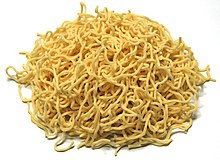
The type of noodles used in ramen are called chūkamen (中華麺, lit. 'Chinese noodles'), which are derived from traditional Chinese alkaline noodles known as jiǎnshuǐ miàn (鹼水麵). Most chūkamen are made from four basic ingredients: wheat flour, salt, water, and kansui, derived from the Chinese jiǎnshuǐ (鹼水), a type of alkaline mineral water containing sodium carbonate and usually potassium carbonate, as well as sometimes a small amount of phosphoric acid. Ramen is not to be confused with different kinds of noodle such as soba, udon, or somen.
The jiǎnshuǐ is the distinguishing ingredient in jiǎnshuǐ miàn, and originated in Inner Mongolia, where some lakes contain large amounts of these minerals and whose water is said to be perfect for making these noodles. Making noodles with jiǎnshuǐ lends them a yellowish hue as well as a firm texture.[citation needed] But since there is no natural jiǎnshuǐ or kansui in Japan, it was difficult to make jiǎnshuǐ miàn or chūkamen before the Meiji Restoration (1868).
Ramen comes in various shapes and lengths. It may be thick, thin, or even ribbon-like, as well as straight or wrinkled.
Traditionally, ramen noodles were made by hand, but with growing popularity, many ramen restaurants prefer to use noodle-making machines to meet the increased demand and improve quality. Automatic ramen-making machines imitating manual production methods have been available since the mid-20th century produced by such Japanese manufacturers as Yamato MFG. and others.[36]
Soup
[edit]
Similar to Chinese soup bases, ramen soup is generally made from chicken or pork, though vegetable and fish stock is also used. This base stock is often combined with dashi stock components such as katsuobushi (skipjack tuna flakes), niboshi (dried baby sardines),[37] shiitake, and kombu (kelp). Ramen stock is usually divided into two categories: chintan and paitan.
- Chintan (清湯), derived from the Chinese qīngtāng (清湯), is a clear stock, made by simmering ingredients and frequently skimming foam and scum off the top of the pot.[35] Chintan stocks are the most common kind, and can be made from chicken, pork, vegetables and/or niboshi.
- Paitan (白湯), derived from the Chinese baitang (白湯), is a broth with an opaque white colored appearance and a creamy consistency that rivals milk, melted butter or gravy (depending on the shop). Paitan stock is made by boiling pork or chicken bones at a high heat for hours at a time, allowing the bones to emulsify into the soup. The most well-known and common paitan stock is Tonkotsu (豚骨, 'pork bone'; not to be confused with tonkatsu). Although tonkotsu is merely a kind of broth, some people consider tonkotsu ramen (specialty of Kyushu, its birthplace) a distinct flavor category.[38] When chicken bones are used to make a paitan stock, the resulting soup is called tori paitan (鶏白湯).
Tare
[edit]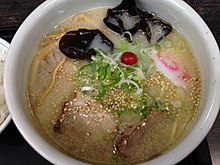


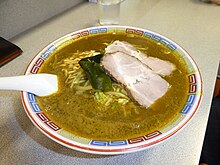
Tare sauce is a sauce that is used to flavor the broth. The main purpose of tare is to provide salt to the broth, but tare also usually adds other flavors, such as umami. There are three main kinds of tare.[35]
- Shio (塩, 'salt') ramen is the oldest of the four types.[38] This tare is made from cooking alcohols like mirin and sake, umami ingredients like kombu, niboshi and MSG, and salt. Occasionally pork bones are also used, but they are not boiled as long as they are for tonkotsu ramen, so the soup remains light and clear. In shio ramen, chāshū is sometimes swapped for lean chicken meatballs, and pickled plums and kamaboko (a slice of processed fish roll sometimes served as a frilly white circle with a pink or red spiral called narutomaki) are popular toppings as well. Noodle texture and thickness varies among shio ramen, but they are usually straight rather than curly. Hakodate ramen is a well-known version of shio ramen in Japan.
- Shōyu (醤油, 'soy sauce') tare is similar to shio tare, but with the addition of soy sauce, which boosts the salty and umami flavor even further. Shōyu ramen usually has curly noodles rather than straight ones, although this is not always the case. It is often adorned with marinated bamboo shoots or menma, scallions, ninjin ('carrot'), kamaboko ('fish cakes'), nori ('seaweed'), boiled eggs, bean sprouts or black pepper; occasionally the soup will also contain chili oil or Chinese spices, and some shops serve sliced beef instead of the usual chāshū.
- Miso (味噌) ramen reached national prominence around 1965. This uniquely Japanese ramen, which was developed in Sapporo Hokkaido, features a broth that combines copious miso and is blended with oily chicken or fish broth – and sometimes with tonkotsu or lard – to create a thick, nutty, slightly sweet and very hearty soup. Miso ramen broth tends to have a robust, tangy flavor, so it stands up to a variety of flavorful toppings: spicy bean paste or tōbanjan (豆瓣醤), butter and corn, leeks, onions, bean sprouts, ground pork, cabbage, sesame seeds, white pepper, chilli and chopped garlic are common. The noodles are typically thick, curly, and slightly chewy.
Toppings
[edit]
After basic preparation, ramen can be adorned with any number of toppings, including but not limited to:[39]
- Chāshū (sliced barbecued or braised pork)
- Negi (green onion)
- Takana-zuke (Pickled and seasoned mustard leaves)
- Seasoned (usually salted) boiled egg (soy egg, ajitsuke tamago or ajitama)
- Bean or other sprouts
- Menma (lactate-fermented bamboo shoots)
- Kakuni (braised pork cubes or squares)
- Kikurage (wood ear mushroom)
- Nori (dried seaweed)
- Kamaboko (formed fish paste, often in a pink and white spiral called narutomaki)
- Squid
- Umeboshi (pickled plum)
- Corn
- Butter
- Wakame (a type of seaweed)
- Olive oil
- Sesame oil
- Mayu (black garlic oil)
- Other types of vegetables
Preference
[edit]Seasonings commonly added to ramen are white pepper, black pepper, butter, chili pepper, sesame seeds, and crushed garlic.[40] Soup recipes and methods of preparation tend to be closely guarded secrets.
Most tonkotsu ramen restaurants offer a system known as kae-dama (替え玉), where customers who have finished their noodles can request a "refill" (for a few hundred yen more) to be put into their remaining soup.[41]
Regional variations
[edit]While standard versions of ramen are available throughout Japan since the Taishō period, the last few decades have shown a proliferation of regional variations, commonly referred to as gotouchi ramen (ご当地ラーメン "regional ramen"). Some of these which have gone on to national prominence are:
- Sapporo, the capital of Hokkaido, is especially famous for its ramen. Most people in Japan associate Sapporo with its rich miso ramen, which was invented there and which is ideal for Hokkaido's harsh, snowy winters. Sapporo miso ramen is typically topped with sweetcorn, butter, bean sprouts, finely chopped pork, and garlic, and sometimes local seafood such as scallop, squid, and crab. Hakodate, another city of Hokkaido, is famous for its salt-flavored ramen,[42] while Asahikawa in the north of the island offers a soy sauce-flavored variation.[43] In Muroran, many ramen restaurants offer Muroran curry ramen.[44]
- Kitakata ramen is known for its rather thick, flat, curly noodles served in a pork-and-niboshi broth. The area within the former city limits has the highest per-capita number of ramen establishments. Ramen has such prominence in the region that locally, the word soba usually refers to ramen, and not to actual soba which is referred to as nihon soba ('Japanese soba').
- Tokyo-style ramen consists of slightly thin, curly noodles served in a soy-flavored chicken broth. The Tokyo-style broth typically has a touch of dashi, as old ramen establishments in Tokyo often originate from soba eateries. Standard toppings are chopped scallion, menma, sliced pork, kamaboko, egg, nori, and spinach. Ikebukuro, Ogikubo and Ebisu are three areas in Tokyo known for their ramen.[citation needed]
- Yokohama ramen specialty is called Ie-kei (家系). It consists of thick, straight noodles served in a soy flavored pork broth similar to tonkotsu, sometimes referred to as, tonkotsu-shoyu. The standard toppings are roasted pork (chāshū), boiled spinach, sheets of nori, often with shredded Welsh onion (negi) and a soft- or hard-boiled egg. It is traditional for customers to customize the softness of the noodles, the richness of the broth and the amount of oil they want.
- Wakayama ramen in the Kansai region has a broth made from soy sauce and pork bones.[45]
- Hakata ramen originates from Hakata district of Fukuoka city in Kyushu. It has a rich, milky, pork-bone tonkotsu broth and rather thin, non-curly and resilient noodles. Often, distinctive toppings such as crushed garlic, beni shōga (pickled ginger), sesame seeds, and spicy pickled mustard greens (karashi takana) are left on tables for customers to serve themselves. Ramen stalls in Hakata and Tenjin are well known within Japan. Recent trends have made Hakataramen one of the most popular types in Japan, and several chain restaurants specializing in Hakata ramen can be found all over the country.
- Tofu ramen is a specialty of Iwatsuki ward in Saitama City.
- Nabeyaki ramen is a specialty of Susaki City, as well as other cities in western Kōchi Prefecture. Nabeyaki ramen is made with a chicken based broth, thin noodles and a soy tare, all served boiling hot in an enamelled pot. Toppings vary, but mainstays include a raw egg that poaches in the bowl, sliced spring onions and chikuwa fish cakes. [46]
- Nagoya ramen specialties include "Taiwan ramen", which despite its name originated in Nagoya and features a very spicy broth. It became famous in the 1980s during a fad for super hot food. It bears some resemblance to danzai noodles but has both a spicy broth and spicy minced meat resulting in an extremely spicy dish.[47]
-
Tokyo-style ramen
-
Kitakata ramen
-
Hakata ramen with tonkotsu soup
-
Wakayama ramen
-
Tsukemen dipping ramen
-
Aburasoba ('oiled noodles')
-
Takayama ramen
-
Hiyashi (chilled) ramen
-
Butter corn ramen, specialty of Hokkaido
-
Sapporo-style ramen
-
Muroran curry ramen
-
Ramen and chahan
Related dishes
[edit]There are many related, Chinese-influenced noodle dishes in Japan. The following are often served alongside ramen in ramen establishments. They do not include noodle dishes considered traditionally Japanese, such as soba or udon, which are almost never served in the same establishments as ramen.
- Nagasaki champon. The noodles are thicker than ramen but thinner than udon. Champon is topped with a variety of ingredients, mostly seafood, stir-fried and dressed in a starchy sauce. The stir-fried ingredients are poured directly over the cooked noodles, with the sauce acting as a soup.
- Tan-men is a mild, usually salty soup, served with a mix of sautéed vegetables and seafood/pork. Not to be confused with tantan-men (see after).
- Wantan-men has long, straight noodles and wonton, served in a mild, usually salty soup.
- Tsukemen ('dipping noodles'). The noodles and soup are served in separate bowls. The diner dips the noodles in the soup before eating. Can be served hot or chilled.
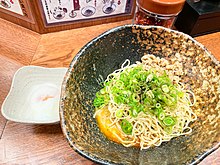
- Tantan-men (担担麺). Japanese version of dan dan noodles, itself a Sichuan specialty. Ramen in a reddish, spicy chili and sesame soup, usually containing minced pork, garnished with chopped scallion and chili and occasionally topped with spinach or bok choi (chingensai).
- Sūrātanmen or sanrātanmen (酸辣湯麺, 'noodles in hot and sour soup') is very similar to Sichuan hot and sour soup, but served with long noodles. The topping ingredients are sautéed and a thickener is added before the mix is poured on the soup and the noodles.
- Abura soba ('oil-noodles'). Ramen and toppings served without the soup, but with a small quantity of oily soy-based sauce instead.
- Hiyashi-chūka (冷やし中華, 'chilled Chinese'). Also known as reimen, esp. in western Japan. A summer dish of chilled ramen on a plate with various toppings (typically thin strips of omelet, ham, cucumber and tomato) and served with a vinegary soy dressing and karashi (Japanese mustard). It was first produced at the Ryutei, a Chinese restaurant in Sendai.
Restaurants in Japan
[edit]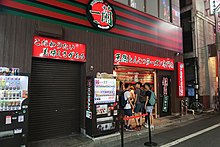
Ramen is offered in various types of restaurants and locations including ramen shops, izakaya drinking establishments, lunch cafeterias, karaoke halls, and amusement parks. Many ramen restaurants only have a counter and a chef. In these shops, the meals are paid for in advance at a ticket machine to streamline the process.[48]
However, the best quality ramen is usually only available in specialist ramen-ya restaurants. Some restaurants also provide Halal ramen (using chicken) in Osaka and Kyoto. As ramen-ya restaurants offer mainly ramen dishes, they tend to lack variety in the menu. Besides ramen, some of the dishes generally available in a ramen-ya restaurant include other dishes from Japanese Chinese cuisine such as fried rice (called chahan or yakimeshi), gyoza (Chinese dumplings), and beer. Ramen-ya interiors are often filled with Chinese-inspired decorations.[49]
From January 2020 and September 2021 during the COVID-19 pandemic, many ramen restaurants were temporarily closed, with 34 chains filing for bankruptcy by September 2020. Ramen restaurants are typically narrow and seat customers closely, making social distancing difficult.[50]
Outside Japan
[edit]Ramen became popular in China where it is known as rìshì lāmiàn (日式拉麵, lit. 'Japanese-style lamian'). Restaurant chains serve ramen alongside Japanese dishes, such as tempura and yakitori. In Japan, these dishes are not traditionally served with ramen, but gyoza, kara-age, and others from Japanese Chinese cuisine.[citation needed]
In Korea, there is a variation of ramen called ramyeon (라면 / 拉麵), made much spicier than ramen. There are different varieties, such as kimchi-flavored ramyeon. While usually served with egg or vegetables such as carrots and scallions, some restaurants serve variations of ramyeon containing additional ingredients such as dumplings, tteok, or cheese as toppings.[51] Famous ramyeon brands include Shin Ramyeon and Buldak Ramyeon.
Outside of Asia, particularly in areas with a large demand for Asian cuisine, there are restaurants specializing in Japanese-style foods such as ramen noodles. For example, Wagamama, a UK-based restaurant chain serving pan-Asian food, serves a ramen noodle soup and in the United States and Canada, Jinya Ramen Bar serves tonkotsu ramen.
Instant ramen
[edit]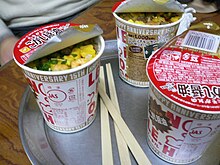
Instant ramen noodles were exported from Japan by Nissin Foods starting in 1971, bearing the name "Oodles of Noodles".[52] One year later, it was re-branded "Nissin Cup Noodles", packaged in a foam food container (It is referred to as Cup Ramen in Japan), and subsequently saw a growth in international sales. Over time, the term ramen became used in North America to refer to other instant noodles.
While some research has claimed that consuming instant ramen two or more times a week increases the likelihood of developing heart disease and other conditions, including diabetes and stroke, especially in women, those claims have not been reproduced and no study has isolated instant ramen consumption as an aggravating factor.[53][54] However, instant ramen noodles, known to have a serving of 43 g, consist of very high sodium.[55] At least 1,760 mg of sodium are found in one packet alone. It consists of 385k calories, 55.7 g of carbohydrates, 14.5 g of total fat, 6.5 g of saturated fat, 7.9 g of protein, and 0.6 mg of thiamine.[56][better source needed]
Canned version
[edit]In Akihabara, Tokyo, vending machines distribute warm ramen in a steel can known as ramen kan (らーめん缶). It is produced by a popular local ramen restaurant in flavors such as tonkotsu and curry, and contains noodles, soup, menma, and pork. It is intended as a quick snack, and includes a small folded plastic fork.[57]
In popular culture
[edit]Emoji
[edit]In October 2010, an emoji was approved for Unicode 6.0 U+1F35C 🍜 STEAMING BOWL for "Steaming Bowl", that depicts Japanese ramen noodles in a bowl of steaming broth with chopsticks.[58] In 2015, the icon was added to Emoji 1.0.[59]
Museum
[edit]The Shin-Yokohama Rāmen Museum is a museum about ramen, in the Shin-Yokohama district of Kōhoku-ku, Yokohama.[60]

See also
[edit]References
[edit]- ^ "日本のラーメンの歴史 – 新横浜ラーメン博物館". Raumen.co.jp. Retrieved 25 May 2022.
- ^ "Unearth the secrets of ramen at Japan's ramen museum". Archived from the original on 28 June 2018. Retrieved 7 March 2018.
- ^ Kodansha encyclopedia of Japan, Volume 6 (1st ed.). Tokyo: Kodansha. 1983. p. 283. ISBN 978-0-87011-626-1.
- ^ Yoshida, Seiichi (1928). 美味しく経済的な支那料理の拵へ方 [How to Prepare Delicious and Economical Chinese Dishes] (in Japanese). Hakubunkan. pp. 368–370. doi:10.11501/1170640.
- ^ Kuroda, Hatsuko (1947). 楽しい家庭料理 (in Japanese). Keihoku Shobo. p. 36. doi:10.11501/1065551.
- ^ a b Media, USEN. "Indespensable Knowledge For Every Ramen Lover! A Glossary with Shop Recommendations". SAVOR JAPAN. Retrieved 20 July 2022.
- ^ a b Kushner, Barak (2012). Slurp! : a social and culinary history of ramen – Japan's favorite noodle soup. Leiden: Global Oriental. ISBN 978-90-04-22098-0. OCLC 810924622.
- ^ a b "Part 1: China Origin". Ramen Culture. Retrieved 20 July 2022.
- ^ 横浜新報社 (June 1903). Yokohama Shinposha (ed.). 横浜繁昌記 : 附・神奈川県紳士録 [Yokohama Prosperity Book : Appendix, Kanagawa Prefecture Gentlemen's Record] (in Japanese). Yokohama Shinposha. p. 138. doi:10.11501/764453.
- ^ Cwiertka, Katarzyna Joanna (2006). Modern Japanese cuisine: food, power and national identity. Reaktion Books. p. 144. ISBN 978-1-86189-298-0.
However, Shina soba acquired the status of 'national' dish in Japan under a different name: rāmen. The change of name from Shina soba to rāmen took place during the 1950s and '60s. The word Shina, used historically in reference to China, acquired a pejorative connotation through its association with Japanese imperialist association in Asia and was replaced with the word Chūka, which derived from the Chinese name for the People's Republic. For a while, the term Chūka soba was used, but ultimately the name rāmen caught on, inspired by the chicken-flavored instant version of the dish that went on sale in 1958 and spread nationwide in no time.
- ^ a b c d e f g h i j k l m n o p q r s t "How Did Ramen Become Popular?". Atlas Obscura. 2007.
- ^ Rupelle, Guy de la (2005). Kayak and land journeys in Ainu Mosir: Among the Ainu of Hokkaido. Lincoln, NE: iUniverse. p. 116. ISBN 978-0-595-34644-8.
- ^ Asakawa, Gil (2004). Being Japanese American. Berkeley, California: Stone Bridge Press. p. 49. ISBN 978-1-880656-85-3.
- ^ NHK World. Japanology Plus: Ramen. 2014. Accessed 2015-03-08.
- ^ Okada, Tetsu (202). ラーメンの誕生 [The birth of Ramen] (in Japanese). Chikuma Shobō. ISBN 978-4480059307.
- ^ a b Okuyama, Tadamasa (2003). 文化麺類学・ラーメン篇 [Cultural Noodle-logy;Ramen] (in Japanese). Akashi Shoten. ISBN 978-4750317922.
- ^ a b Kosuge, Keiko (1998). にっぽんラーメン物語 [Japanese Ramen Story] (in Japanese). Kodansha. ISBN 978-4062563024.
- ^ "Japanese Noodles (No. 4)". Kikkoman Corporation (in Japanese). Retrieved 20 July 2022.
- ^ "榨菜肉丝面的南北差异及制作方法". Sohu.
- ^ "Yokohama Chinatown Part 2 – Yokohama, Kanagawa". JapanTravel. 14 November 2020. Retrieved 20 July 2022.
- ^ "Yokohama Chinatown". THE GATE. Retrieved 20 July 2022.
- ^ 仏書刊行会 (1913). Bussho Publishing Society (ed.). 大日本仏教全書 [Complete works of Buddhism in Japan] (in Japanese). Bussho Publishing Society. p. 1174. doi:10.11501/952839.
- ^ a b Okumura, Ayao (25 November 2017). 麺の歴史 ラーメンはどこから来たか [The History of Noodles: Where Did Ramen Come From]. Kadokawa Sophia Bunko (in Japanese). KADOKAWA / Kadokawa Gakugei Shuppan. ISBN 978-4044002923.
- ^ Shin-Yokohama Raumen Museum
- ^ Japanese ramen secret history "Nikkei Sangyo Shimbun premium series, (in Japanese). 『日本ラーメン秘史』日経プレミアムシリーズ、2011
- ^ 新横浜ラーメン博物館「日本のラーメンの歴史」
- ^ 横田文良 (2009). "『天津飯』のルーツを探る". 中国の食文化研究<天津編>. 辻学園調理・製菓専門学校、ジャパンクッキングセンター. p. 10. ISBN 978-4-88046-409-1.
- ^ 林陸朗、高橋正彦、村上直、他, ed. (1991). 日本史総合辞典. Tokyo Shoseki. p. 947. ISBN 978-4487731756.
- ^ a b Ong, Shi Han (18 August 2020). "Rairaiken, Japan's First-Ever Ramen Restaurant, Reopens At Shin-Yokohama Ramen Museum After A 44-Year Hiatus".
- ^ McGee, Oona (26 October 2020). "Japan's first-ever ramen restaurant reopens after 44 years".
- ^ Griffiths, Owen (29 August 2018). "Need, Greed, and Protest in Japan's Black Market, 1938–1949". Journal of Social History. 35 (4): 825–858. doi:10.1353/jsh.2002.0046. JSTOR 3790613. S2CID 144266555.
- ^ "Japan votes noodle the tops". BBC News. 12 December 2000. Retrieved 25 April 2007. BBC News
- ^ Japanorama, Series 3, Episode 4. BBC Three, 9 April 2007
- ^ a b Demetriou, Danielle (23 February 2016). "The holy grail of ramen dishes". BBC Travel. Retrieved 26 August 2018.
- ^ a b c Satinover, Mike (2020). The Ramen_Lord Book of Ramen. pp. 4–6.
- ^ "Fusion of cultures nets stellar ramen at Ichimi". miamiherald. Retrieved 18 January 2019.
- ^ "10 Great Tastes of Japan" (PDF). Ministry of Agriculture, Forestry and Fisheries; Government of Japan. 18 June 2010. p11: Noodles. Archived (PDF) from the original on 28 August 2019. Retrieved 13 July 2021.
- Whole web page which links to the PDF above: "Publications". Ministry of Agriculture, Forestry and Fisheries; Government of Japan. Japanese Cuisine and Ingredients. Archived from the original on 1 November 2020. Retrieved 13 July 2021.
- ^ a b Davis, Elizabeth (12 February 2016). "6 Glorious Types of Ramen You Should Know". Tastemade. Retrieved 31 July 2020.
- ^ "40 Best Ramen Toppings for Your Homemade Noodle Soup". Recipe.net. 3 June 2021. Retrieved 2 May 2022.
- ^ Hou, Gary G. (16 February 2011). Asian Noodles: Science, Technology, and Processing. John Wiley & Sons. ISBN 978-1-118-07435-0.
- ^ "Hakata Ramen (Nagahama Ramen) FAQ". Mukai.dameningen.org. Archived from the original on 1 April 2012. Retrieved 18 November 2012.
- ^ Nate (17 December 2009). "函館らーめん大門 (Hakodate Ramen Daimon)". Ramenate!. Retrieved 18 November 2012.
- ^ "Asahikawa Travel: Asahikawa Ramen". japan-guide.com. Retrieved 26 September 2013.
- ^ 加盟店一覧 (50音順) (24 January 2013). "室蘭カレーラーメンの会 » 北海道ラーメン第4の味を目指して・・・". Muroran-curryramen.com. Retrieved 28 September 2015.
{{cite web}}: CS1 maint: numeric names: authors list (link) - ^ Hiufu Wong, Maggie (7 June 2013). "10 things that make Wakayama Japan's best kept secret". CNN Travel. Cable News Network. Turner Broadcasting System, Inc. Retrieved 22 November 2014.
- ^ Gurutabi. "Nabeyaki Ramen". Kyoudo Ryouri. kyodoryori-story. Retrieved 2 June 2024.
- ^ Tzu-hsuan, Liu. "FEATURE: Delving into the origins of Nagoya's 'Taiwan ramen'". taipeitimes.com. Taipei Times. Retrieved 26 February 2024.
- ^ Organization, Japan National Tourism. "Ramen 101". Japan Travel. Retrieved 25 June 2019.
- ^ Organization, Japan National Tourism. "Ramen". Japan Travel. Retrieved 25 June 2019.
- ^ McCurry, Justin (13 November 2020). "Return of a ramen pioneer gives boost to Japan's Covid-hit restaurant sector". The Guardian. ISSN 0261-3077. Retrieved 13 November 2020.
- ^ Back to Korean-Style Ramyeon at Nenassi's Noodle Bar
- ^ "Inventor of instant noodles dies" BBC News. 6 January 2007
- ^ "Harvard Study Reveals Just How Much Damage Instant Noodles Do to Your Body". Snopes.com. 6 July 2016. Retrieved 3 March 2017.
- ^ "Health Column: The risks behind those ramen noodles". 13 September 2014. Retrieved 31 January 2016.
- ^ "Instant Noodles or Ramen", Asian Foods, CRC Press, pp. 73–77, 5 April 1999, doi:10.1201/9781482278798-28, ISBN 9780429179143, retrieved 2 November 2021
- ^ "Private and General Acute Care Medical Centre | Parkway East Hospital". www.parkwayeast.com.sg. Retrieved 2 November 2021.
- ^ "Ramen-can: a topic in Akihabara". Archived from the original on 24 July 2008. Global Pop Culture
- ^ "Picture This: A List of Japanese Emoji". Nipppon.com. 29 April 2019.
- ^ "Steaming Bowl Emoji". Emojipedia. Retrieved 10 March 2017.
- ^ "Ramen Museum". Retrieved 18 June 2008.
Further reading
[edit]- Orkin, Ivan (2013). Ivan Ramen: Love, Obsession, and Recipes from Tokyo's Most Unlikely Noodle Joint. Berkeley, Calif.: Ten Speed Press. ISBN 9781607744467. OCLC 852399997.
- "The art of the slurp (or, How to eat ramen)". The Splendid Table. 4 April 2014. Retrieved 7 April 2014. Interview with the author.
- How to Customize your Ramen – Toppings and Japanese Vocabulary





